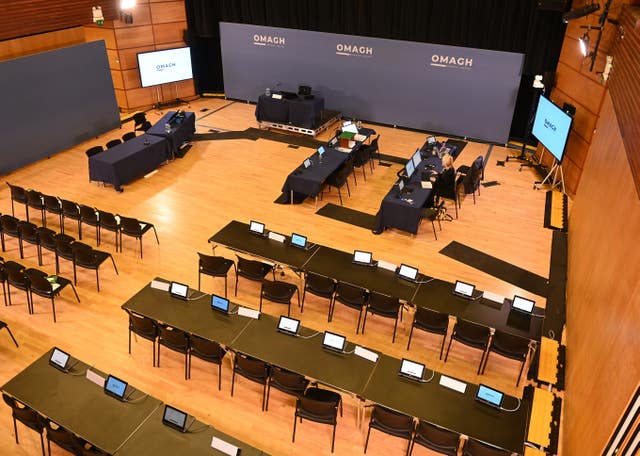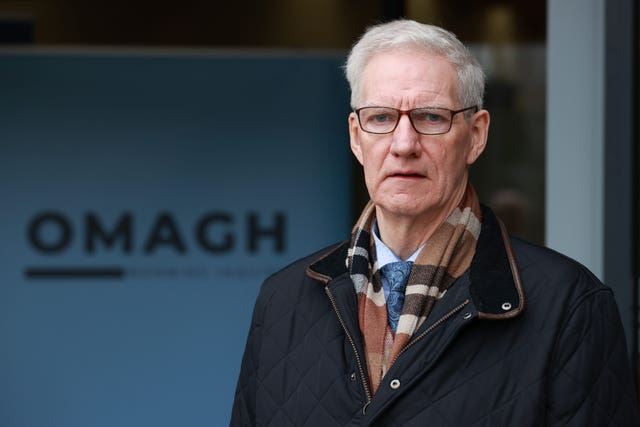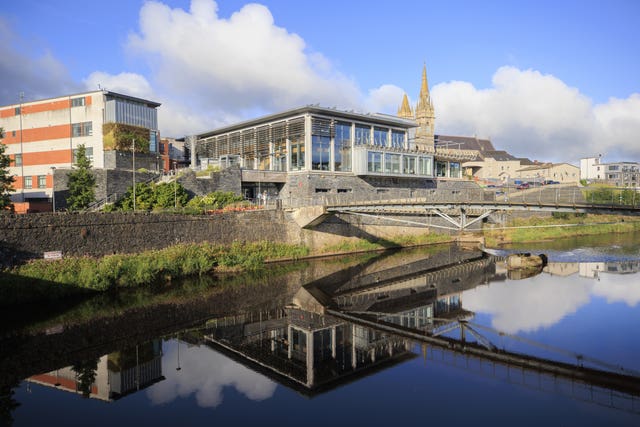Police felt ‘guilty and responsible’ for evacuating people closer to Omagh bomb
Retired superintendent James Baxter has been giving evidence to the Omagh Bombing Inquiry.

The police commander in Omagh on the day the town was bombed has said many of his officers felt “guilty and responsible” that they had evacuated members of the public towards the explosive device.
Retired superintendent James Baxter also told the Omagh Bombing Inquiry of the trauma caused to victims due to more than 70 hoax bomb warnings in the town in the years following the massacre.
Twenty-nine people, including a woman pregnant with twins, were killed when the Real IRA bombed the Co Tyrone town in August 1998.
The public inquiry, being held at the Strule Arts Centre, has been hearing statements from police officers who were part of the initial response to the bombing.

The public inquiry was set up by the Government to examine whether the explosion could have been prevented by the UK authorities.
Mr Baxter was the RUC sub-divisional commander in Omagh on the day of the blast.
He told how he was off-duty when he received a call that there had been a bomb warning. The warning incorrectly stated the bomb was close to the courthouse and many people were evacuated in the direction of Market Street.
Mr Baxter said he heard on the news a short time later that a bomb had exploded and headed to the town’s RUC station to assume command of the police operation.
The retired officer told the hearing that on the Saturday evening he went to Omagh Leisure Centre, which was being used as an information centre for relatives.
He said: “I witnessed the raw emotion of scores of people attempting to obtain information about relatives who were reported as missing.
“I was approached by several people known to me as they were in a very distressed state as they had no knowledge of the whereabouts of family members.”
He then went to the town’s army barracks where the gym was being used as a temporary mortuary.
He said: “I observed that several of the deceased had been moved to this location and were laid out in rows and covered with sheets.
“The sight of the bodies laid out in this temporary mortuary was very distressing and brought home vividly the impact of the atrocity which had been inflicted on the people of Omagh.”

Mr Baxter said he then inspected the room where families would be taken for formal identification of loved ones.
He had agreed that flowers should be moved to the family room to give it a more “warm and pleasant atmosphere for those who would soon be required to perform the terrible task of identifying the bodies”.
He added: “These flowers were in place and I recall a box of tissues also set in place, which would be used continuously throughout the long night of identification.”
He told the inquiry he saw a body in the identification room and realised it was a family member of personal friends of his.
He added: “Over the following hours, I was devastated to learn of the number of injured being treated in hospital and of the number of fatalities.
“As I learned the names of those who had died, I also realised that many were known to me personally.
“Despite the emotional impact that I was experiencing, I knew I had to continue to function in a professional manner.”
He said he later learnt that one of the dead was his son’s girlfriend.
“Unable to return home, I contacted my wife by telephone and asked her to break the news to my son.”
Mr Baxter said he resumed his duties on Sunday morning following a few hours’ rest.
He said: “The scale of the atrocity resulted in multiple requests for visits to the town by individuals deemed to be VIPs by both political and public backgrounds.
“The requests seemed never-ending and severely stretched my available resources.”
He said he visited the homes of the families of many of the dead in the following days.
He said: “I found this to be the most difficult and emotional duty of my career as I met with family members devastated by their loss in such a horrific manner.”
One of the homes he visited was that of the family of his son’s girlfriend.
He said: “Whilst attempting to act in a professional manner I found that I too was grieving because of my son’s girlfriend’s death.
“My wife and I felt the loss very severely.”
Mr Baxter said he attended many funerals over the following days.
He said he also had to provide welfare support for his officers.
He added: “I spoke to many who had been involved in evacuating people away from the area of the courthouse where the bomb call related to.
“Many of those people evacuated made their way down Market Street to the very site of the bomb blast and some were either fatally or seriously injured.
“It was apparent that many were seriously traumatised and felt guilty and responsible for moving people into the area of the bomb.
“I referred many officers to the police occupational health unit for professional counselling.”
Mr Baxter said in the following months there were multiple hoax bomb warnings in the town, using the same code word as in the Real IRA explosion.
He said they all required the evacuation of the town centre.
He said a bomb warning in September 2000, while the Omagh inquests were taking place, was the 68th police had received since August 1998.
Mr Baxter said the hoaxes caused “untold stress and anxiety” for victims and police officers.
He told the inquiry that an arrest was eventually made in Co Donegal of an individual who was responsible for more than 70 hoax bomb alerts.
Mr Baxter concluded: “The impact of the bomb and subsequent events on my wellbeing were such that I cut my police career short and left in 2003.”

Later, statements from officers who were involved in the police operation in the immediate aftermath of the explosion were read to the inquiry.
A PSNI superintendent who was an RUC constable in Omagh at the time of the bombing said it was his belief that the Real IRA set out to murder police in the blast.
Norman Haslett also told the inquiry that what he saw and heard at the scene resembled “hell”.
Similarly, the man who was duty sergeant at the Omagh Police Station on the day of the bombing said officers were faced with a “smell of death” in the aftermath of the explosion.
Philip Marshall, who retired from the PSNI in 2009 as a chief inspector, accused the bombers of not giving police enough information to determine where the bomb would be: “They didn’t give a damn about the consequences.”
The inquiry also heard from Richard Scott, who was an RUC constable in Omagh, who said his life had been “forever changed” by his experiences on the day.
Both Mr Scott and Mr Marshall told the inquiry that they had been diagnosed with PTSD after the horrific sights they witnessed following the bombing.
Allan Palmer, an RUC constable in 1998, described how he had attempted to help victims, despite suffering injuries himself.
He said: “I remember seeing all the people who were in front of me lying dead and those who remained alive had sustained serious injuries.”
The inquiry was then suspended while the funeral of Tracey Devine, who was severely injured in the 1998 explosion which also killed her daughter Breda, was taking place.
The inquiry had previously been told that Ms Devine had died on Saturday.





